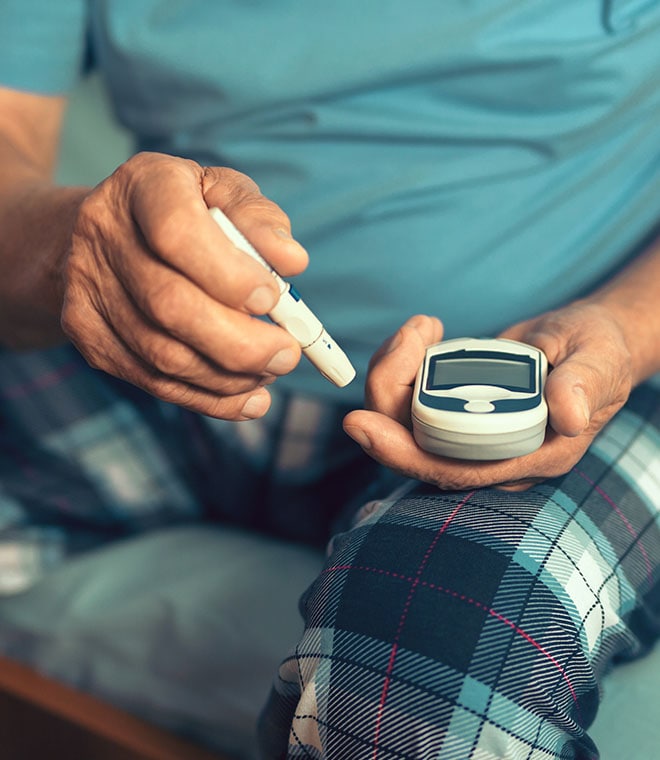Health
What is prediabetes?
By Michelle Katz, MS, RD, certified diabetes care and education specialist May 16, 2025 • 8 min
More than 98 million (1 in 3) adults in the U.S. have prediabetes, putting them at an increased risk for developing type 2 diabetes. If you have been diagnosed with prediabetes, working with your healthcare provider to develop and follow an appropriate care plan now could delay or possibly prevent the onset of type 2 diabetes. The first step is understanding exactly what prediabetes is and what you can do to address the issue.
What does prediabetic mean?
Prediabetes is the term used to describe elevated blood glucose (sugar) levels that are outside of the normal range. However, the levels aren’t yet high enough for a healthcare provider to diagnose you with type 2 diabetes. Those with prediabetes may be referred to as prediabetic.
Prediabetes doesn’t only develop in adults. It can also develop in children and young adults. Nearly 1 in 5 adolescents ages 12 to 18 and 1 in 4 young adults ages 19 to 34 have prediabetes.
What causes prediabetes?
People can develop prediabetes in one of two ways:
- If the body’s cells don’t respond properly to insulin, the hormone that regulates how much sugar enters your cells to be used as energy, the levels of sugar in your blood may rise above normal range.
- If the pancreas, which produces insulin, doesn’t make enough to meet the body’s needs, blood glucose levels may become too high.
Some factors that increase your risk of developing prediabetes include:
- Weight: People who are overweight or obese are more likely to become resistant to insulin due to excess body fat.
- Age: Your risk of prediabetes increases as you reach your 30s and 40s. However, it’s possible for this condition to start at a younger age.
- Genetics: If you have a close relative with diabetes, you’re at a higher risk for developing both prediabetes and diabetes.
- Lifestyle: Not getting enough physical activity increases the risk of prediabetes. Smoking may also make body cells more resistant to insulin, increasing your risk as well.
- Health history: People who have high blood pressure, high cholesterol, heart disease, obstructive sleep apnea or polycystic ovary syndrome (PCOS) are more likely to develop prediabetes. It’s also more common among people who previously had gestational diabetes or a stroke.
How is prediabetes diagnosed?
Healthcare providers typically use two blood tests to diagnose prediabetes. The first is the fasting plasma glucose (FPG) test, which detects your blood sugar levels after you have fasted for at least eight hours. A normal FPG level is 99 mg/dL or less. The prediabetes range is 100 to 125 mg/dL. The type 2 diabetes range is 126 mg/dL or more.
The second test used to diagnose prediabetes is the A1C test, which tells healthcare providers your average blood sugar levels over the past three months. The normal level is below 5.7%. For type 2 diabetes, it’s 6.5% and above. The A1C range for prediabetes is between 5.7% and 6.4%.
What are the symptoms and signs of prediabetes?
It’s possible to have elevated blood sugar levels without experiencing any prediabetes symptoms. In fact, many people don’t know they have it until they undergo routine blood work. One possible warning sign is darkened skin around the neck, groin and/or armpits. Some people also get small skin growths called skin tags in these same areas. Changes in eyesight can also be an indication of prediabetes.
If prediabetes progresses, you could develop symptoms of type 2 diabetes, which include:
- Increased hunger and thirst
- More frequent urination
- Blurred vision
- Tingling or numbness in the hands and feet
- Fatigue
- Frequent infections
- Unexplained weight loss
- Wounds and sores taking longer to heal
What are common prediabetes treatments?
In most cases, treatment for prediabetes focuses on a two-pronged approach: making lifestyle changes to reduce the risk of type 2 diabetes and carefully monitoring blood sugar levels to ensure that the problem doesn’t worsen over time. A prediabetes care plan may include:
- Healthy diet: Your healthcare provider will likely encourage you to reduce your intake of refined carbohydrates and saturated fats and to add more green vegetables, lean proteins and whole grains to your plate. A registered dietitian can help you develop an eating plan tailored to your needs.
- Exercise: Increasing your physical activity may improve the way your cells respond to insulin. The general guideline is 150 minutes of moderate-intensity exercise or 75 minutes of high-intensity aerobic exercise per week. However, your healthcare provider can help you decide how much physical activity is right for you.
- Weight management: If you’re overweight or obese, losing as little as 5% to 7% of your body weight could make a positive impact on blood glucose levels. A healthy diet and exercise plan can contribute to weight loss. Making these changes can cut your risk of developing type 2 diabetes in half.
- Medications: Healthcare providers may prescribe the drug metformin for people who are at a very high risk for type 2 diabetes. This drug limits the amount of glucose that your body absorbs from foods and reduces glucose production by the liver. Your healthcare provider may also recommend that you take cholesterol or blood pressure-lowering medications if necessary.
Checking your blood sugar at home
Your healthcare provider may ask you to check your blood sugar levels at home. Keeping track of your numbers will allow your healthcare provider to evaluate the effectiveness of your prediabetes management plan and diagnose type 2 diabetes early if the condition worsens.
One way to check your blood sugar is with a glucometer, which measures glucose levels in small blood samples you collect by pricking your finger with a device called a lancet. You apply a drop of blood to a test strip, which you insert in the device to get your reading.
Lowering your risk of type 2 diabetes
Talk to your healthcare provider about your prediabetes risk factors. They can order blood work to check for the condition and discuss your next steps so you can begin getting your blood glucose levels under control. If you have prediabetes, the right care plan could delay or prevent the onset of type 2 diabetes.
Updated by Rebeca Thomas RN, BSN, May 2025.
- https://www.cdc.gov/diabetes/communication-resources/prediabetes-statistics.html
- https://www.cdc.gov/diabetes/prevention-type-2/prediabetes-prevent-type-2.html
- https://medlineplus.gov/prediabetes.html
- https://my.clevelandclinic.org/health/diseases/21498-prediabetes
- http://main.diabetes.org/dorg/PDFs/what-is-prediabetes.pdf
- https://www.cdc.gov/diabetes/diabetes-testing/index.html
- https://www.mayoclinic.org/diseases-conditions/prediabetes/symptoms-causes/syc-20355278
- https://medlineplus.gov/druginfo/meds/a696005.html
- https://www.cdc.gov/diabetes/diabetes-testing/monitoring-blood-sugar.html
- https://www.health.harvard.edu/blog/is-blood-sugar-monitoring-without-diabetes-worthwhile-202106112473
- https://diabetes.org/get-involved/advocacy/continuous-glucose-monitors
- https://medlineplus.gov/diabeticdiet.html
- https://www.heart.org/en/healthy-living/fitness/fitness-basics/aha-recs-for-physical-activity-in-adults
- https://www.cdc.gov/physical-activity-basics/adding-adults/what-counts.html

